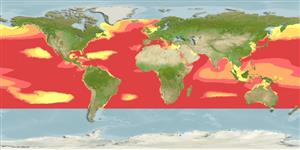Common names from other countries
Environment: milieu / climate zone / depth range / distribution range
Ecologia
marinhas batipelágico; intervalo de profundidade 10 - 2000 m (Ref. 27000), usually 200 - 900 m (Ref. 33390). Deep-water; 67°N - 40°S, 180°W - 180°E
Atlantic, Indian and South Pacific: in tropical and subtropical waters, including the Mediterranean. Also known from the temperate North Atlantic as far as 66°N and in the sub-Antarctic water south of Australia.
Comprimento de primeira maturação / Tamanho / Peso / Idade
Maturity: Lm ?, range 2 - ? cm
Max length : 4.6 cm SL macho/indeterminado; (Ref. 128822); idade máx. registrada: 1.00 anos (Ref. 5162)
Descrição suscinta
Chaves de identificação | Morfologia | Morfometria
Espinhos dorsais (total) : 0; Raios dorsais (total) : 13 - 15; Espinhos anais: 0; Raios anais : 18 - 20.
Oceanic, precise depth range dependent upon developmental stage, latitude, season (Ref. 4769). Generally horizontally oriented (Ref. 4769). Feeds on small zooplankton, mostly copepods (Ref. 5162). Sexually dimorphic with large females and small males (Ref. 9503). Sex ratio vary with size groups but is about 1:1 around spawning. Length-frequency histograms are bimodal; has a two-year life cycle (Ref. 82363).
Badcock, J., 1984. Gonostomatidae. p. 284-301. In P.J.P. Whitehead, M.-L. Bauchot, J.-C. Hureau, J. Nielsen and E. Tortonese (eds.) Fishes of the north-eastern Atlantic and the Mediterranean. volume 1. UNESCO, Paris. (Ref. 4769)
Status na Lista Vermelha da UICN (Ref. 130435)
CITES (Ref. 128078)
Not Evaluated
Ameaça para os humanos
Harmless
Uso pelos humanos
Pescarias: sem interesse
Ferramentas
Relatórios especiais
Baixar XML
Fontes da internet
Estimates based on models
Preferred temperature (Ref.
115969): 3.9 - 16.3, mean 9.3 (based on 2108 cells).
Índice de diversidade filogenética (Ref.
82804): PD
50 = 0.5001 [Uniqueness, from 0.5 = low to 2.0 = high].
Bayesian length-weight: a=0.00389 (0.00171 - 0.00885), b=2.99 (2.79 - 3.19), in cm Total Length, based on LWR estimates for this (Sub)family-body shape (Ref.
93245).
Nível Trófico (Ref.
69278): 3.1 ±0.18 se; based on food items.
Resiliência (Ref.
120179): médio(a), tempo mínimo de duplicação da população 1,4 - 4,4 anos (tm=2; Fec=200).
Fishing Vulnerability (Ref.
59153): Low vulnerability (10 of 100).
